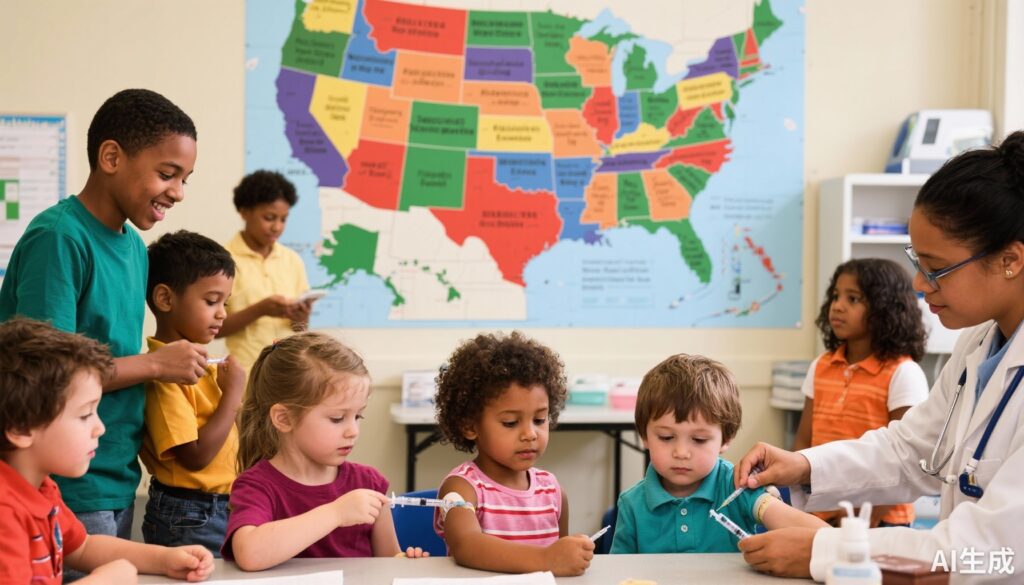Highlight
- Repealing nonmedical vaccine exemptions in several US states significantly increased kindergarten vaccination rates for key vaccines including DTaP, hepatitis B, MMR, and polio.
- Reduction of overall vaccine exemption rates was approximately 3.2 percentage points within three years following repeal in states with total exemption repeal.
- Minimal substitution to medical exemptions occurred, indicating that repeal policies effectively improved immunization coverage without driving exemption shifts.
- Partial repeal states showed smaller and less sustained improvements in vaccination rates compared to full repeal states.
Study Background
Childhood vaccination is a cornerstone of preventive pediatric healthcare, critical for controlling vaccine-preventable diseases such as measles, diphtheria, and pertussis. However, in recent years, vaccination rates among children in the United States have experienced declines in several states, often fueled by growing vaccine hesitancy and an increasing number of parents seeking nonmedical exemptions for religious or philosophical reasons. This has contributed to localized outbreaks and threatens herd immunity, especially in early childhood settings like schools. In response, several states have enacted legislation to repeal nonmedical vaccine exemptions to bolster community immunity and reduce preventable disease spread.
Study Design
This investigation was a cross-sectional study analyzing annual, state-level data on kindergarten vaccination and exemption patterns collected by the Centers for Disease Control and Prevention (CDC) from the 2011 through 2023 school years. The study used a staggered difference-in-differences design, enabling comparison between states that repealed nonmedical vaccine exemptions and those maintaining their exemption policies over time. The target population included kindergarten students attending both public and private schools across 37 to 43 states, depending on specific outcome data availability.
States with total repeal of nonmedical exemptions included California (2015), New York (2019), Maine (2019), and Connecticut (2021). Partial repeal states, such as Vermont (2015) and Washington (2019), were analyzed separately to assess differential impact.
Primary outcomes were state-level vaccination rates among kindergarteners for diphtheria-tetanus-acellular pertussis (DTaP), hepatitis B, measles-mumps-rubella (MMR), and polio vaccines. Secondary outcomes included overall exemption rates—both medical and nonmedical.
Key Findings
Following total repeal of nonmedical exemptions, states which included approximately 2.8 million kindergarten children observed a substantial decrease in overall exemption rates by 3.2 percentage points (95% CI, 1.9 to 4.4) within three years. Correspondingly, vaccination coverage increased significantly across the four key vaccines assessed:
- DTaP vaccination rates rose by 4.1 percentage points (95% CI, 3.3 to 4.9).
- Hepatitis B vaccination rates increased by 2.8 percentage points (95% CI, 2.1 to 3.5).
- MMR vaccine uptake improved by 4.0 percentage points (95% CI, 3.1 to 4.9).
- Polio vaccination rates rose by 3.8 percentage points (95% CI, 2.9 to 4.6).
Importantly, the transition away from nonmedical exemptions was not substantially offset by an increase in medical exemptions, which rose modestly by just 0.4 percentage points (95% CI, 0.04 to 0.7), indicating minimal substitution.
In contrast, states with only partial repeal of nonmedical exemptions demonstrated smaller and less persistent improvements in vaccination rates, suggesting that comprehensive repeal policies have a more robust impact.
These results underscore that legislative interventions targeting nonmedical vaccine exemptions can effectively enhance immunization coverage among school-aged children and potentially reduce the risk of vaccine-preventable disease outbreaks.
Expert Commentary
The findings from Bald et al. provide robust evidence supporting the public health benefit of removing nonmedical vaccine exemptions. By analyzing extensive state-level data over more than a decade, the study methodologically strengthens the causal inference between policy change and vaccination behavior. The observed modest effect on medical exemptions counters concerns about potential exploitation of medical exemptions as loopholes post-repeal.
Some limitations include the ecological nature of state-level data, which may not capture local heterogeneity in coverage or demographic factors influencing vaccine uptake. Additionally, the analysis predominantly reflects data from states with specific repeal timing and legislative environments, which may impact generalizability to other states or contexts. Nonetheless, this work aligns with prior research demonstrating that stricter vaccine exemption policies correlate with improved vaccination rates and reduced incidence of vaccine-preventable diseases.
Biologically and epidemiologically, improving vaccination coverage in early childhood is essential to maintain herd immunity thresholds, particularly for highly contagious diseases like measles, which require coverage rates exceeding 90-95% to prevent outbreaks.
Conclusion
The repeal of nonmedical vaccine exemptions at the state level is associated with meaningful increases in kindergarten vaccination rates for multiple critical vaccines, with minimal compensatory increase in medical exemptions. These data support policy efforts aiming to curtail nonmedical exemptions as an effective strategy to maintain high community vaccination coverage amid rising vaccine hesitancy.
Future research should investigate the long-term epidemiologic impact of these policies on disease incidence, as well as explore strategies to address vaccine hesitancy more broadly, including education and community engagement. As vaccine-preventable diseases remain a persistent threat, evidence-based policy remains a key component of comprehensive public health efforts to protect children and communities.
Funding and Clinical Trials
The study was published as an original investigation in JAMA Pediatrics. No specific funding source was indicated in the reference provided. The data utilized were public surveillance data from the CDC. There was no clinical trial registration applicable to this observational policy study.
References
1. Bald A, Gold S, Yang YT. State Repeal of Nonmedical Vaccine Exemptions and Kindergarten Vaccination Rates. JAMA Pediatr. 2025 Oct 27:e254185. doi:10.1001/jamapediatrics.2025.4185. Epub ahead of print. PMID: 41143818; PMCID: PMC12560026.
2. Omer SB, et al. Nonmedical exemptions to school immunization requirements: Secular trends and association of state policies with pertussis incidence. JAMA. 2006;296(14):1757-1763.
3. Opel DJ, et al. The Influence of Provider Communication Behaviors on Parental Vaccine Acceptance and Visit Experience. Am J Public Health. 2013;103(10):e32–e39.
4. Olive JK, et al. Public responses to policy changes in nonmedical vaccine exemptions. Vaccine. 2018;36(9):1239-1244.



